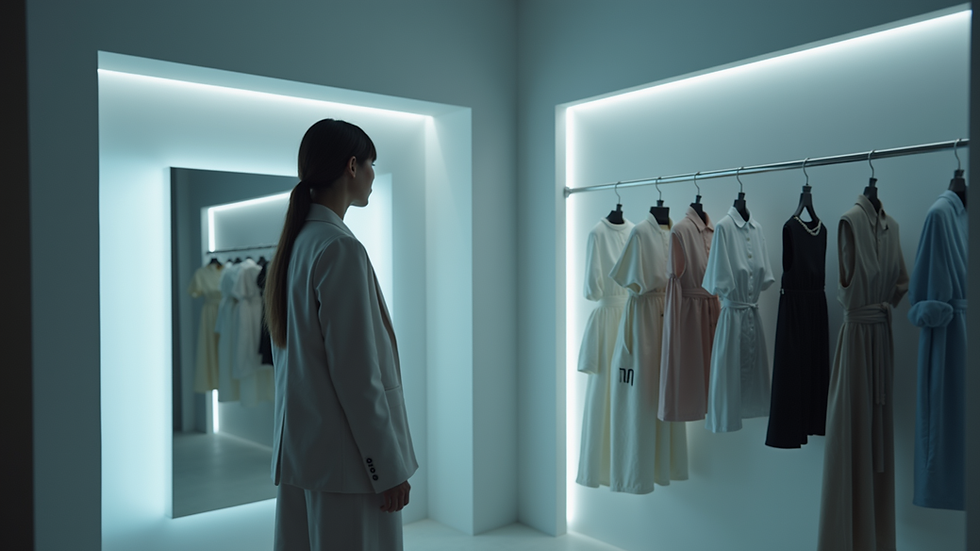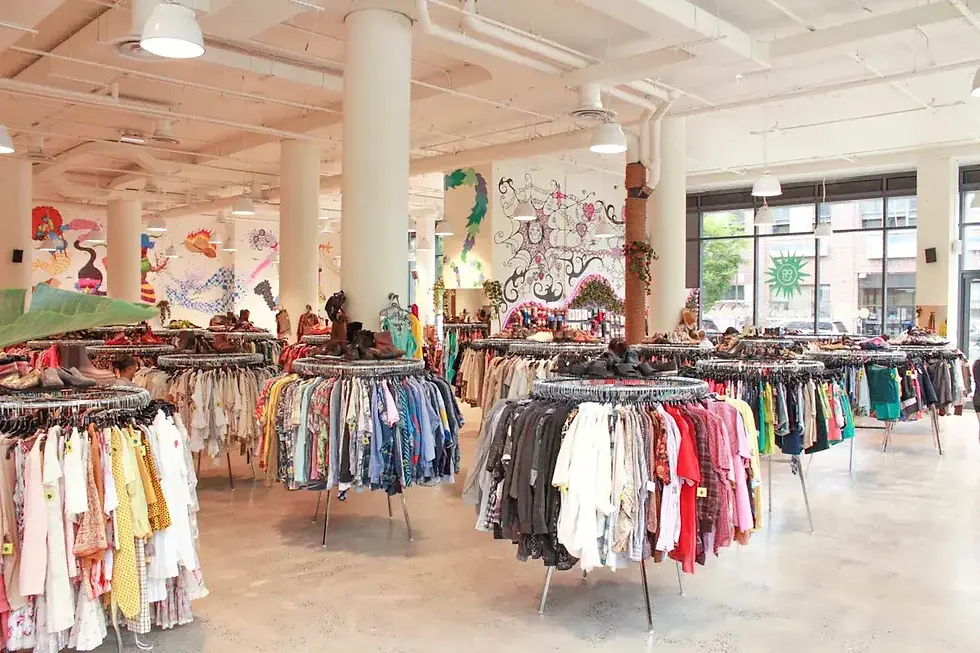Runway.exe: How Artificial Intelligence is Revolutionizing Fashion Design and Consumer Experience
- Brandon Francis
- Sep 24
- 4 min read
Artificial intelligence isn’t creeping into fashion. It's surprisingly been making waves in the fashion industry. At New York Fashion Week 2025, AI wasn’t just a backstage helper. It was projecting neon visuals, remixing heritage silhouettes, and even acting like a stylist telling you what to wear.
This blog dives into how AI went from a buzzword to playing a major role in fashion. We’ll look at how it inspires designers, how it changes shopping for consumers, and how it saves retailers from losing money on returns. While also explaining the risks.

Why Fashion Inspiration Matters
Fashion has always reflected the world around it. In the 1960s, bold colors and psychedelic prints were pulled from counterculture and political protest. In the 1990s, minimalism aligned with the era of globalization and a “clean slate” aesthetic. The sources of inspiration change, but the rule stays the same: what inspires designers today ends up in closets tomorrow.
Now in 2025, the loudest environment influencing fashion isn’t just music, art, or politics. It’s the technological environment, especially AI. When tech becomes the new inspiration, the whole industry shifts.
Technology as a Source for Inspiration
Tech isn’t just a tool anymore; it’s the whole mood board. Designers don’t just sketch by hand. They let AI toss in wild suggestions, mash up eras, and remix patterns no human would have thought of before.
However, this doesn’t replace creativity. It amplifies it. In the same way drum machines pushed hip-hop into new territory, AI is pushing fashion into new aesthetics.
NYFW 2025: Humans × Algorithms
At New York Fashion Week 2025, AI stole scenes left and right.
Immersive visuals turned runways into digital theaters. Projections washed over the models, mixing heritage references with neon sci-fi effects. Archive remixes rebooted classic designs with futuristic flair, like taking a vintage silhouette and throwing in digital-inspired textures. And AI stylists went live, showing consumers how outfits could actually fit into their existing closets.
This wasn’t about robots taking over. It was about humans and algorithms tag-teaming. Designers acted like directors, curating the ideas AI offered and turning them into fashion statements.

Why Designers Use AI
There are real reasons designers are plugging into AI:
Speed. Instead of spending days sketching 50 versions of a dress, AI generates them in minutes.
Experimentation. Designers can test outrageous looks digitally without burning through fabric.
Inspiration. AI throws curveball combinations that humans wouldn’t consider or have thought about.
Forecasting. By analyzing consumer data, AI predicts what trends will land next season, making it easier to balance art with commerce.
Translation: AI is practical. It helps designers dream and helps collections sell.
The Consumer Side
AI isn’t just changing what designers make. It’s changing how we shop.
Virtual try-ons let people see clothes on their digital selves before buying. No more ordering three sizes and praying one fits. AI stylists work like a digital best friend who always knows what looks good, recommending outfits based on your closet, your body type, and your vibe.
This means shopping is less stressful and more fun. Instead of a chore, it feels like a video game where you’re the main character, swapping skins until you find the perfect one.

Retailers and AI
Retailers use AI because it saves serious money.
Better sizing tools cut return rates, which can be a massive financial drain. Smarter inventory predictions keep stores from overstocking pieces nobody buys. Brands positioning themselves as “AI-powered” also get instant relevance with younger shoppers who expect tech to be part of everything.
On top of that, AI gives stores more data on what’s working. If a certain look gets a spike in virtual try-ons, retailers can double down on production. If something flops digitally, they avoid wasting money.
Benefits of AI in Fashion
The upsides of AI are stacking up:
Personalization. Consumers feel like the brand is designing just for them.
Sustainability. Less fabric waste since more experimenting happens digitally.
Inclusivity. AI models can represent diverse body types, not just one “sample size.”
Global reach. Designers can localize campaigns faster and connect across cultures.
These aren’t abstract promises. They’re the practical wins turning AI from a shiny gimmick into a legit toolkit.
Concerns and Challenges
AI isn’t perfect. Some people question authenticity, worrying that AI waters down human artistry. Not every consumer has the devices or internet speed to use these tools, creating accessibility gaps. And the legal side is messy: who actually owns an AI-generated design, the human, the machine, or the brand?
If fashion doesn’t figure out these questions, AI could go from inspiration to controversy fast. The move is to innovate with taste and keep humans in control.
My Connection
This hits home for me because I also use AI in my creative grind. Whether it’s music production, visuals, or branding, AI feels less like a machine and more like a co-creator. It pushes me to try ideas I wouldn’t have thought of on my own.
So when I see designers working with AI, it makes sense. We’re both trying to stretch creativity past human limits. Technology isn’t replacing the vision. It’s giving us a bigger canvas to paint on.
Final Thoughts
AI isn’t killing fashion. It’s feeding it. The technological environment is now fashion’s muse, just as culture, art, and politics were in earlier decades. Designers direct, algorithms expand, and audiences get something new.
For consumers, that means more personalization and less guesswork. For retailers, it means fewer returns and more cultural clout.
Bottom line: AI isn’t just a tool. It’s fashion’s partner in imagination. And right now, the runway is running on algorithms.
References
Chhabra, E. (2025, September 20). How designers used AI at New York Fashion Week. The Washington Post. https://www.washingtonpost.com/style/fashion/2025/09/20/artificial-intelligence-nyfw-ai/
Heuritech. (2025, April 22). AI and creativity in fashion: Bridging gaps. Heuritech. https://heuritech.com/articles/artificial-intelligence-fashion-creativity/
The Guardian. (2024, February 8). How AI is ‘amplifying creativity’ in the fashion world. The Guardian. https://www.theguardian.com/fashion/2024/feb/08/ai-london-fashion-week




Comments